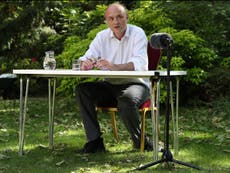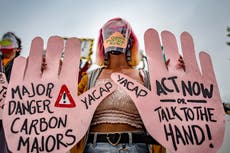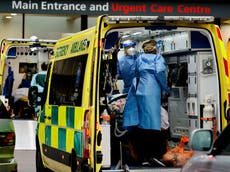Your support helps us to tell the story
From reproductive rights to climate change to Big Tech, The Independent is on the ground when the story is developing. Whether it's investigating the financials of Elon Musk's pro-Trump PAC or producing our latest documentary, 'The A Word', which shines a light on the American women fighting for reproductive rights, we know how important it is to parse out the facts from the messaging.
At such a critical moment in US history, we need reporters on the ground. Your donation allows us to keep sending journalists to speak to both sides of the story.
The Independent is trusted by Americans across the entire political spectrum. And unlike many other quality news outlets, we choose not to lock Americans out of our reporting and analysis with paywalls. We believe quality journalism should be available to everyone, paid for by those who can afford it.
Your support makes all the difference.As 2020 comes to an end, the coronavirus pandemic has dominated almost every aspect of normal life around the world since the beginning of the year.
Since the very first cases reported in Britain in January, there have been lockdowns, changing restrictions and tens of thousands of infections and deaths in the UK alone. Globally, 82.1 million Covid-19 cases have been recorded, with 1.79 million deaths.
The first official reports of cases of the novel coronavirus emerged in Wuhan, in China’s Hubei province, in December 2019.
We look back on some of the biggest moments in the coronavirus pandemic this past year.
January
23 January: Beijing cancels Chinese New Year events in an effort to contain the novel coronavirus.
30 January: The World Health Organisation (WHO) confirmed 7,818 total confirmed coronavirus cases worldwide, with the majority in China and 82 cases reported in 18 countries outside China. The WHO’s director-general, Tedros Adhanom Ghebreyesus declares Public Health Emergency of International Concern (PHEIC).
31 January: First two cases of coronavirus confirmed in the UK.
February
4 February: China completes brand new 1,000-bed hospital in Wuhan in under two weeks.
28 February: First British death from Covid-19 confirmed by Japanese health ministry - a man who was quarantined on the Diamond Princess cruise ship.
29 February: First case of local transmission recorded in a man in Surrey, who was infected while in the UK and had no recent travel history.
March
5 March: First coronavirus death in UK confirmed, number of positive cases exceed 100.
11 March: WHO declares the Covid-19 outbreak is a pandemic.
13 March: Premier League 2019-20 season is suspended, adding to growing list of worldwide sporting cancellations and postponements. Local elections, London mayoral election and police and crime commissioner elections are postponed to next year.
16 March: Boris Johnson tells people to work from home if possible and avoid venues such as pubs and clubs. However, the government does not tell such premises to close.
17 March: NHS England announces from 15 April all non-urgent operations in England will be postponed to free up 30,000 beds.
20 March: Prime minister Boris Johnson orders all pubs, restaurants and cafes to close that night, except for takeaway. Nightclubs, theatres, cinemas, gyms, leisure centres are told to close “as soon as they reasonably can”.
23 March: Mr Johnson announces UK-wide lockdown from 26 March, public told they must stay at home and will only be allowed outside for essential shopping, one form of exercise a day, medical purposes or travel to and from work when “absolutely necessary”.
24 March: Health secretary Matt Hancock announces building of NHS Nightingale Hospital at the ExCel London.
27 March: The prime minister tests positive for coronavirus.
April
2 April: Mr Hancock sets 100,000 tests a day target by end of April.
3 April: The first Nightingale Hospital opens at the ExCel London, with 500 beds and potential capacity for 4,000. Other Nightingale Hospitals are set to open across the country later in the month.
6 April: Mr Johnson’s condition worsens and he is moved to St Thomas’ Hospital’s intensive care unit. His condition begins to improve a few days after.
11 April: Number of people in London hospitals reaches peak, but patient numbers continue to rise elsewhere. Occupancy of critical care beds in England peaks at around 58 per cent of capacity, Northern Ireland reported peak of 51 per cent earlier in the month.
12 April: Mr Johnson discharged from hospital and continues recovery at Chequers.
20 April: UK’s deputy chief scientific adviser Professor Dame Angela Maclean says number of confirmed cases is “flattening out”, number of people in hospital begins to fall in Scotland, Wales and every region of England.
26 April: The prime minister returns to Downing Street.
May
1 May: Mr Hancock confirms government’s target of providing, but not necessarily completing, 100,000 tests a day by end of April has been met, with 122,347 provided over previous 24 hours.
10 May: Government updates message from “stay at home, protect the NHS, save lives” to “stay alert, control the virus, save lives”. New alert system announced from green (level one) to red (level five). Boris Johnson addresses nation to outline “conditional plan” to reopen society, urges those who cannot work from home to return to work the next day but to avoid public transport if possible.
20 May: PHE data shows no new Covid-19 cases reported in London over 24-hour period up to Monday 18 May
28 May: Contact tracing systems go live in England and Scotland, but Dido Harding tells MPs system in England will not be “fully operational at a local level” until end of June. Mr Johnson announces from 1 June, people in England will be able to meet in groups of up to six people outdoors in gardens or outdoor private spaces.
30 May: Boris Johnson announces relaxing of restrictions for 2.2 million people who have been “shielding”.
June
4 June: Mandatory face coverings on public transport to be introduced from 15 June.
10 June: Mr Johnson announces further easing of lockdown measures from 13 June, allowing people who live alone to form “support bubble”.
15 June: Non-essential retail, outdoor attractions and places of worship allowed to reopen. Hospitality sector and close-contact services, as well as entertainment and leisure facilities still closed.
15 June: Non-essential retail, outdoor attractions and places of worship allowed to reopen. Hospitality sector and close-contact services, as well as entertainment and leisure facilities still closed.
23 June: Government announces that social distancing rules for England will be relaxed from 4 July, people required to stay one metre apart but two metres whenever possible. Pubs, restaurants, hotels, hairdressers allowed to reopen, but spas, nail bars and gyms must remain closed. Two households allowed to meet up indoors from 4 July. Weddings with up to 30 guests permitted.
25 June: NHS Test and Trace figures show in first three weeks of operation, more than 100,000 people have been asked to self-isolate after being contacted by contact tracers.
29 June: Matt Hancock announces reintroduction of stricter lockdown measures for Leicester, including closure of non-essential retail shops and closure of schools, following spike in cases. People advised to stay at home and avoid all but essential travel.
July
3 July: Government publishes list of countries on travel corridor, which means arrivals into England from those countries will not have to quarantine from 10 July, including Greece, France, Belgium and Spain. Changes do not apply to Scotland, Wales or Northern Ireland.
10 July: Face coverings become mandatory in shops in Scotland. England later follows suit from 24 July.
13 July - Nail bars, beauty salons, tattoo parlours and body and skin piercing services allowed to reopen.
17 July: Mr Johnson announces further easing of lockdown restrictions for England, with plans for a “significant return to normality by Christmas. People allowed to use public transport for non-essential journeys. Extra £3bn funding for NHS in England announced to help prepare for possible second wave of Covid-19 over coming winter.
22 July: Care home visits permitted to resume in England with one constant visitor per resident.
25 July: PHE warns that being obese and overweight puts people at greater risk of severe illness or death due to Covid-19. Travellers from Spain required to quarantine amid fears of second wave gripping Europe.
30 July: ONS figures show that England had highest number of excess deaths in Europe between end of February and mid-June, and had second highest peak in number of deaths behind Spain. Social restrictions placed on Greater Manchester and parts of East Lancashire and Yorkshire from midnight following surge in cases.
31 July: Mr Johnson postpones some lockdown easing measures scheduled to begin on 1 August for two weeks. ONS household survey indicates cases in England are rising again.
August
6 August: 50 million face masks purchased by government for use by NHS England in April will not be used due to safety concerns
13 August: Revamped contact tracing app begins public trials. Boris Johnson announces further easing of lockdown measures to allow for reopening of bowling alleys, casinos and soft play centres.
14 August: Government figures indicate R number between 0.8 and 1 in England, but Sage says they re not confident number is below 1.
25 August: Face coverings made compulsory for students in communal areas of schools in Scotland. UK government subsequently issues new guidelines requiring pupils in schools in areas with tight lockdown restrictions to wear face coverings in corridors and other communal areas.
September
September saw serious issues arise with England’s Test and Trace system as demand for testing rose sharply.
9 September: “Rule of six” to come into force, as social gatherings of more than six people banned from 14 September amid rise in cases. Boris Johnson announces “Operation Moonshot” plan to expand mass virus testing in bid to further control the virus.
11 September: Birmingham bans mixing of households in Birmingham and neighbouring Solihull and Sandwell from 15 September as cases reach 90.3 per 100,000 people.
17 September: Local lockdown measures announced for Newcastle-upon Tyne, Gateshead, Sunderland, Northumberland, South Tyneside, North Tyneside and County Durham following rise in cases in the northeast of England. Tighter restrictions announced for Lancashire, Merseyside, Warrington, Halton, Wolverhampton, Oadby, Wigston, parts of Bradford, Kirklees and Calderdale the following day.
18 September: NYE fireworks display in London cancelled.
21 September: Pubs and restaurants in England ordered to close at 10pm from 24 September and be restricted to table service only by law.
22 September: Mr Johnson announces new restrictions, including a limit on wedding guests to 15 people and mandatory face coverings for all shop staff. People are told to work from home if they can.
24 September: Second version of NHS contact-tracing app made available to download in England and Wales.
25 September: 1,700 students at Manchester Metropolitan University told to self-isolate after 99 tested positive for Covid-19, marking the beginning of nightmare for thousands of students who will be told to self-isolate in university accommodation.
29 September: Number of coronavirus deaths worldwide surpasses one million.
October
2 October: US president Donald Trump and his wife Melania test positive for coronavirus, begins self-isolation.
6 October: Largest daily increase in number of daily Covid-19 hospital admissions in England since June recorded, with 478 new admissions.
14 October: New tier system comes into force, with Liverpool City Region becoming first to be assigned to strictest tier. London, most of Essex, York, North East Derbyshire, Chesterfield, Erewash, Elmbridge and Barrow in Furness moved to tier 2 from 16 October. Mayor Andy Burnham and local politicians in Greater Manchester resist plans to put the area into tier 3, ask for additional financial support.
20 October: Boris Johnson breaks deadlock with Greater Manchester leaders by announcing the region will be moved to tier 3 from 23 October, after failing to reach a deal for financial support. He later announced £60m of funding for Greater Manchester.
23 October: Fatality rate in England from coronavirus increases for first time since peak in April. More areas enter tier 3, Wales enters its own 17-day firebreak lockdown.
31 October: Mr Johnson announces a second national lockdown for England, from 5 November to 2 December, to prevent a “medical and moral disaster” for the NHS. He said England will revert to the tier system after the lockdown.
November
As England entered its second lockdown, the public’s mood became darker. Anti-lockdown protests were attended by hundreds throughout the country, with police chiefs criticising those who marched as “selfish”.
3 November: Liverpool announces it is to begin piloting a regular Covid-19 rapid testing trial with support from around 2,000 military personnel from 6 November.
18 November: Baroness Dido Harding, head of NHS Test and Trace, receives an alert she had been in contact with an infected person and begins self-isolating.
21 November: Downing Street confirms plans to introduce tougher three-tier system when lockdown ends, following criticism from the scientific community that the current tier system did not go far enough to control the virus.
24 November: Transport secretary Grant Shapps announces travellers arriving in England from 15 December can reduce their quarantine period by paying for a Covid test after five days.
26 November: New tier system announced, with most of the country put in tier 2 and large parts of the Midlands, northeast and northwest of England in tier 3.
December
Boris Johnson announced a relaxation of coronavirus rules for five days over the Christmas period, that would have allowed people to mix with up to two other households indoors, from 23 to 25 December. But the emergence of a new variant of coronavirus that is highly transmissible meant these plans could no longer go ahead, with the prime minister abandoning them just days before Christmas.
2 December: Pfizer/BioNTech Covid-19 vaccine candidate approved for use in the UK by the Medicines and Healthcare products Regulatory Agency (MHRA).
4 December: ONS figures show that infection rates are falling in every part of England apart from the northeast.
8 December: 91-year-old Margaret Keenan becomes person to receive Pfizer/BioNTech vaccine in the UK.
9 December: Experts call for London to be placed into tier 3 after figures indicate a spike in cases in the capital on 2 December.
14 December: Mr Hancock announces London, most of Essex and parts of Hertfordshire will move to tier 3 from 16 December. New variant of coronavirus that is more transmissible also announced.
19 December: Mr Johnson announces London, southeast and east of England to enter new Tier 4 restrictions after exponential rise in cases and amid fears over new coronavirus strain spreading rapidly through the country. The planned relaxation of rules for Christmas were scrapped for those in tier 4, while the rest of England and Wales were limited to meeting up only on Christmas Day.
23 December: Mr Hancock announces Sussex, Oxfordshire, Suffolk, Norfolk, Cambridgeshire, Hampshire and parts of Essex and Surrey will be moved to tier 4 from Boxing Day. Many other areas will be moved up a tier.
28 December: 20,426 people are being treated in hospital for Covid-19 in England, an increase from around 19,000 during the previous peak in April.
30 December: MHRA approves Covid-19 vaccine from Oxford/AstraZeneca for use in the UK.












Join our commenting forum
Join thought-provoking conversations, follow other Independent readers and see their replies
Comments